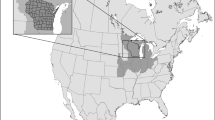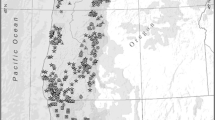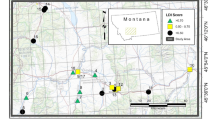Abstract
This paper illustrates a set of simple tools that may be used to assess and communicate the biophysical condition of river and riparian habitat in urban catchments. The tools are based upon information collected using the Urban River Survey (URS), a habitat survey designed for application to 500 m stretches of urban river corridor, and comprise (i) a series of aggregate indices, (ii) three classifications relating to the materials, habitat and vegetation characteristics of urban river stretches, which contribute to an overall score, the Stretch Habitat Quality Index (SHQI), and (iii) two environmental gradients which define a URS matrix of engineering:habitat associations. This toolkit may be used to gather and exchange knowledge about urban river habitat quality to a wide range of specialist or non-technical stakeholders and local community members. It may be used to provide information at the catchment and reach scales to support stakeholder discussions and decision making relating to initial site selection for restoration works; to post project appraisal; and to track changes in river character across space and through time. Example applications of the tools are provided using URS surveys undertaken on tributaries of the River Thames within London in comparison with an archive of previous surveys from three other urban river systems. These tools are being validated in London as part of a larger interdisciplinary research project that is testing the suitability of this type of approach in the context of the London Rivers Action Plan, Water Framework Directive, and urban green space regeneration.







Similar content being viewed by others
References
Boitsidis AJ, Gurnell AM, Scott M, Petts GE, Armitage PD (2006) A decision support system for identifying the habitat quality and rehabilitation potential of urban rivers. Water Environ J 20:1–11
Booth DB, Henshaw PC (2001) Rates of channel erosion in small urban streams. In: Wigmosta M, Burges S (eds) Land use and watersheds: human influence on hydrology and geomorphology in urban and forest areas, AGU Monograph Series, Washington D.C., Water Science and Application Volume 2, 17–38
Brown LR, Cuffney TF, Coles JF, Fitzpatrick F, McMahon G, Steuer J, Bell AH, May JT (2009) Urban streams across the USA: lessons learned from studies in 9 metropolitan areas. J N Am Benthol Soc 28(4):1051–1069
Chin A (2006) Urban transformation of river landscapes in a global context. Geomorphology 79:460–487
Chin A, Gregory KJ (2005) Managing urban river channel adjustments. Geomorphology 69:28–45
Davenport AJ, Gurnell AM, Armitage PD (2001) Classifying urban rivers. Water Sci Technol 43:147–155
Davenport AJ, Gurnell AM, Armitage PD (2004) Habitat survey and classification of urban rivers. River Res Appl 20:687–704
Dudgeon D, Arthington AH, Gessner MO, Kawabata ZI, Knowler DJ, Lévêque C, Naiman RJ, Prieur-Richard AH, Soto D, Stiassny MLJ, Sullivan CA (2006) Freshwater biodiversity: importance, threats, status and conservation challenges. Biol Rev 81:163–182
Environment Agency (2008) London rivers action plan. Downloaded from http://www.therrc.co.uk/lrap/lplan.pdf on 6 July 2011
European Commission (2000) Directive 2000/60/EC establishing a framework for Community action in the field of water policy. EU Water Framework Directive (WFD)
Finkenbine JK, Atwater JW, Mavinic DS (2000) Stream health after urbanization. AWRA paper number 98161. J Am Water Resour Assoc 36:1149–1160
Frissell CA, Bayles D (1996) Ecosystem management and the conservation of aquatic biodiversity and ecological integrity. J Am Water Resour Assoc 32:229–240
Groffman PM, Bain DJ, Band LE, Belt KT, Brush GS, Grove TM, Pouyat RV, Yesilonis IC, Zipperer WC (2003) Down by the riverside: urban riparian ecology. Front Ecol Environ 1(6):315–321
Gurnell AM, Lee M, Souch C (2007) Urban rivers: hydrology, geomorphology, ecology and opportunities for change. Geogr Compass 1(5):1118–1137
Gurnell AM, Shuker L, Lee M, Boitsidis AJ (2011) Gradients in the Biophysical Structure of Urban Rivers and their association with Channel Engineering. River Research and Applications, early view
McBride M, Booth DB (2005) Urban impacts on physical stream condition: effects of spatial scale, connectivity, and longitudinal trends. J Am Water Resourc Assoc 41:565–580
Morley SA, Karr JR (2002) Assessing and restoring the health of urban streams in the puget sound basin. Conserv Biol 16:1498–1509
Niezgoda SL, Johnson PA (2005) Improving the urban stream restoration effort: identifying critical form and processes relationships. Environ Manag 35(5):579–592
Olivera F, DeFee BB (2007) Urbanization and its effect on runoff in the whiteoak Bayou watershed, Texas. J Am Water Resour Assoc 43:170–182
Pizzuto JE, Hession WC, McBride M (2000) Comparing gravel-bed rivers in paired urban and rural catchments of Southeastern Pennsylvania. Geology 28:79–82
Raven PJ, Fox PJA, Everard M, Holmes NTH, Dawson FD (1997) River Habitat Survey: a new system to classify rivers according to their habitat quality. In: Boon PJ, Howell DL (eds) Freshwater quality: defining the indefinable? The Stationary Office, Edinburgh, pp 215–234
Raven PJ, Holmes NTH, Naura M, Dawson FH (2000) Using river habitat survey for environmental assessment and catchment planning in the U.K. Hydrobiologia 422–423:359–367
Roy AH, Freeman MC, Freeman BJ, Wenger SJ, Meyer JL, Ensign WE (2006) Importance of riparian forests in urban catchments contingent on sediment and hydrologic regimes. Environ Manag 37(4):523–539
Tapsell SM (1995) River restoration: what are we restoring to? a case study of the Ravensbourne river, London. Landsc Res 20(3):98–111
Trimble SW (1997) Contribution of stream channel erosion to sediment yield from an urbanizing watershed. Science 278:1442–1444
Walsh CJ, Roy AH, Feminella JW, Cottingham PD, Groffman PM, Morgan RP (2005) The urban stream syndrome: current knowledge and the search for a cure. J N Am Benthol Soc 24:706–723
Wang L, Lyons J, Gong ZG, Liu YL, Zhang JJ (2001) Impacts of urbanization on stream habitat and fish across multiple spatial scales. Environ Manag 28(2):255–266
White MD, Greer KA (2006) The effects of watershed urbanization on the stream hydrology and riparian vegetation of Los Peñasquitos Creek, California. Landsc Urban Plan 74(2):125–138
Acknowledgements
This research has been funded as part of an interdisciplinary ESRC/NERC research studentship ES/F012314/1 and builds upon an approach developed with funding first from the UK Natural Environment Research Council’s URGENT Programme (Grant GST/02/1977) and subsequently within the EU Life Demonstration project SMURF (LIFE02 ENV/UK/000144). Thanks are also due for the enormous support of many individuals within the Environment Agency, Thames River Restoration Trust, the Wandle Trust, Thames 21 and all who have contributed valuable time and assistance in field surveys.
Author information
Authors and Affiliations
Corresponding author
Rights and permissions
About this article
Cite this article
Shuker, L., Gurnell, A.M. & Raco, M. Some simple tools for communicating the biophysical condition of urban rivers to support decision making in relation to river restoration. Urban Ecosyst 15, 389–408 (2012). https://doi.org/10.1007/s11252-011-0207-2
Published:
Issue Date:
DOI: https://doi.org/10.1007/s11252-011-0207-2




